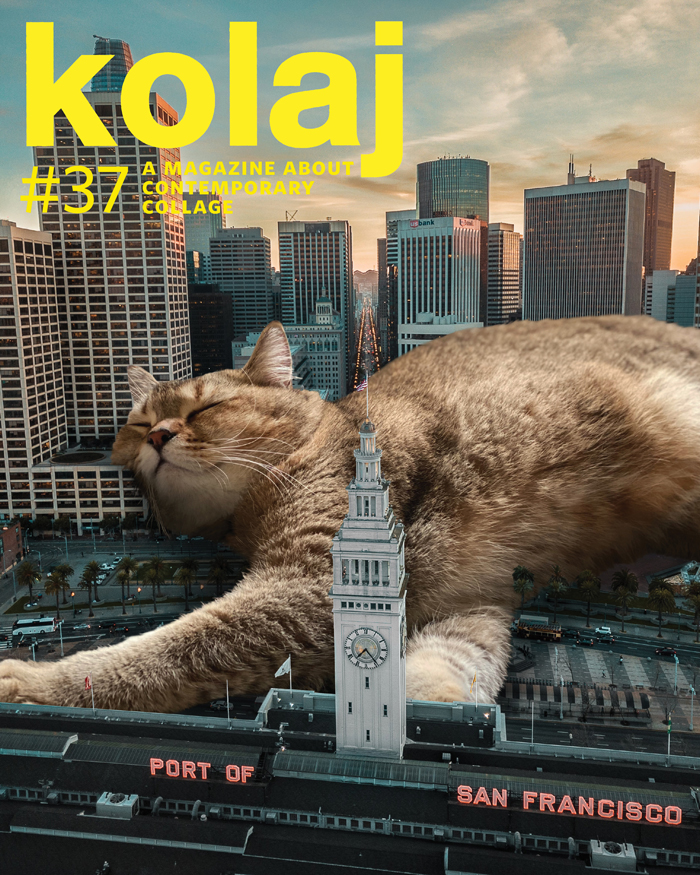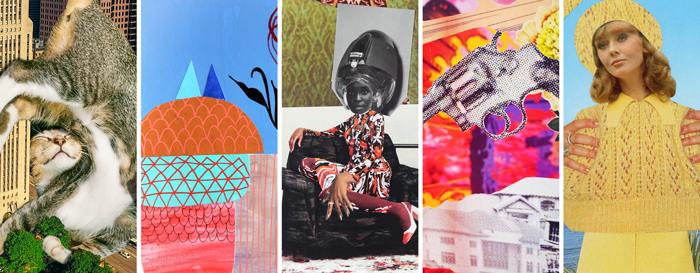
Kolaj is a quarterly, printed, 10″x8″ art magazine
featuring reviews and surveys of contemporary collage. The magazine takes an international perspective on collage as a medium, a genre, a community, and a 21st century art movement.
SUBSCRIBE OR ORDER A COPY
INSIDE THE ISSUE
Cats. Cats in space. Cats lounging around buildings. San Fran Cat Nap by Matt McCarthy is on the cover of Kolaj 37. This digital collagist from Chapel Hill, North Carolina, USA “transports viewers to a world that’s similar to our own, but also features massive felines stalking our landscapes” and has a lot of fun doing so. A portfolio of his work appears in the issue.
On the back cover is Boudoir by Bria Sterling-Wilson. The analogue collagist writes, “There is a strong sense of power and self-awareness presented in my collages. The black women displayed in my collages are filling these spaces and owning their environment, bodies, and identity.”
In the issue editorial, “The Future of Art”, Ric Kasini Kadour considers the role of artists in the world of artificial intelligence. He writes, “The purveyors of AI Art fundamentally underestimate the role of artists. While the technology purports to make something new, in reality, all it does is regurgitate the past. An algorithm cannot hope.”
In our round-up of News & Notes from the world collage, we report on the collage artist chosen by the Louisiana Book Festival; on Texas-based collagist Deborah Roberts‘ copyright lawsuit against another artist and their gallery; and on Australian collagist Kellie O’Dempsey receipt of the 2022 “Art for Life” Award from the Flying Arts Alliance as part of the Queensland Regional Art Awards. Also, Scottish filmmaker David Rushton’s film about Kurt Schwitters was one of 50 films selected for the European Short Film Festival in Berlin.
In the article, “A Mix of Joy & Solemnity”, Richard D. Mohr on the abstract collages of Inuit artist Janet Kigusiuq (Baker Lake, Nunavut, 1926-2005). Mohr writes, “By wholly abstract, I mean that the common observer, even one attuned to the relevant artist’s culture, could not tell just by looking at an image whether its subject is animal, vegetable or mineral or has any genus let alone species—without being provided a history of its production or a sign of the maker’s intent.”
What happens when you bring together sixty-four international artists and invite them to present artwork about science? In the issue, we offer a preview of “Unconnected Yet”, a collage exhibition that imagines the gap between art and science at the Academy of Fine Arts in Kolkata, India. Co-curator Todd Bartel writes, “At its center, ‘Unconnected Yet’ began by wondering how to connect art with science in a forward-looking way.”
For many artists, the idea of a residency, if considered at all, seems rarefied, an idea to pursue in the future or something that “other artists” take part in. Questions also creep in: how could traveling somewhere else, away from one’s studio or kitchen table, be useful? What purpose would a residency possibly serve for the already established artist? In “Connecting & Creating”, Jennie Hinchcliff reports on Kolaj Institute’s Collage Artist Residency: Scotland, which took place in September 2022 in Sanquhar, Scotland.
Since 2018, Bart Heesen, a letterpress artist, has teamed up with collagist Rob Benders under the moniker Tintenkillers. The Dutch duo delivers an unorthodox art and education program that uses collage to engage around social issues. Their recently published book, COOLLAGE: A Closer Look, speaks to their unique approach to art education. We review the book in the issue.
Mark Vargo asks if Artificial Intelligence technology is a tool for collage artists. He writes, “These AI generators have fueled a massive flood of new digital content, including millions of new images. Along with this generated content, inevitable controversy has arisen. However, even in light of these controversies, there still may be beneficial uses of this technology for collage artists.”
Collagist Celia Crane called on artists to “submit small collage works on the theme ‘Todo y Nada’ (‘Everything and Nothing’) for an exhibition in celebration of the 5th annual World Collage Day.” The works were shown 14-31 May 2022 at Crane’s Vayo Collage Gallery in Rochester, New York. Fifty-three works from artists in fifteen countries were included in The Deck of Everything & Nothing, a collaged set of playing cards.
Atlanta-based artist Shanequa Gay was deeply impacted by The Atlanta Child Murders of the 1970s and 80s. Over a two-year period, between 1979 and 1981, at least 28 children, adolescents, and adults were killed. Many years later Gay uses collage to make sense of the past. Jonathan Shipley writes in his profile of Gay, “Her collage work, like the unsolved deaths, are redolent with secrets, mystery, the power of memory, the hope of a future, something new, something different and meaningful.”
New York-based collagist Lynn Gall is making folklore. Her new book, Mythical Creatures in Collage, offers a printed collection of surreal collage figures that blend science fiction, emerging mythology, and speculative folklore with the artist’s “craftsmanship and an unusual point of view.” The article “Mythical Creatures: Cyborgs, Greek Chimeras, & Exquisite Corpses” is a review of her book.
In the issue we offer a report on Kolaj Institute’s recent and upcoming activities including upcoming book projects, exhibitions at the Knoxville Museum of Art, residencies and workshops. The article also speaks of Kolaj Institute’s plans for World Collage Day (13 May 2023) and Kolaj Fest New Orleans (7-11 June 2023).

Artist Portfolios
Margarita Brum
Montevideo, Uruguay
“I am very interested in the mixture of ancestral knowledge with contemporary elements and techniques, the use of embroidery as an expressive resource and not only decorative, is something present in my work.”
Bria Sterling-Wilson
Baltimore, Maryland, USA
“I construct pieces that are very alluring; however, once you observe them closer, there is a deeper meaning. As an artist, I think we have a choice to make art that is for aesthetic purposes or to use our artistic abilities to advocate, spread awareness, and start conversations. I choose to use my platform to share black stories and black beauty! Through collage I can balance those two elements of aesthetic and advocacy, which is quite gratifying.”
Mary A. Johnson
Alfred, New York, USA
“Collage is about pulling materials from their point of origin, and placing them into a new context. It’s about redefining an image, or a component or an idea–what you see isn’t always what you get.”
Matt McCarthy
Chapel Hill, North Carolina, USA
“I collect images from the public domain daily and a large portion of my practice is looking through images and waiting for connections. It’s intangible, but I believe that the more images I consume on a daily basis, the more it trains my brain to see links between them.”
Sanne Karenko
Vlissingen, The Netherlands
“A collage to me is like making a picture with a camera but with the liberty to add elements that are missing, developing images that I see in my imagination.”
